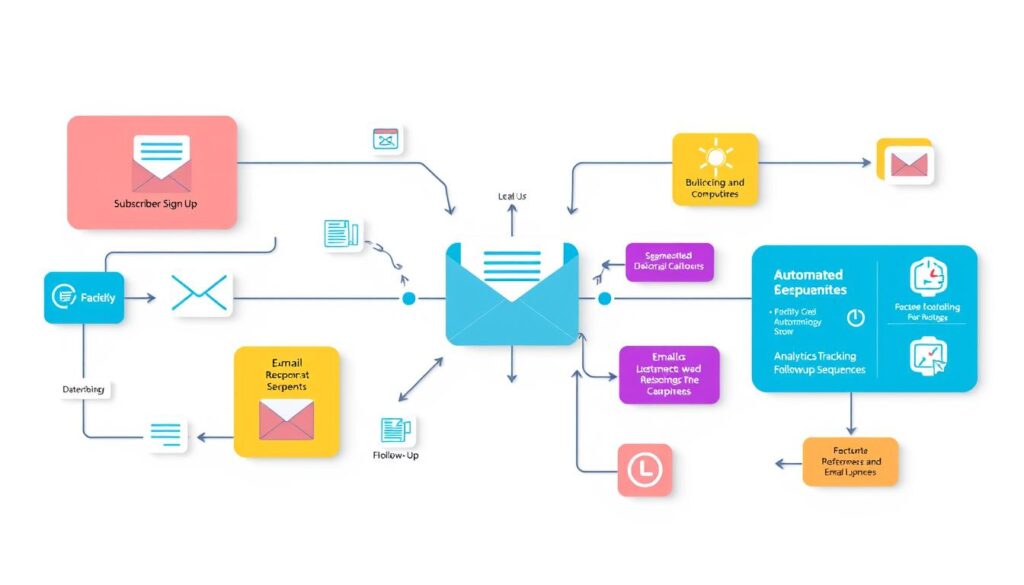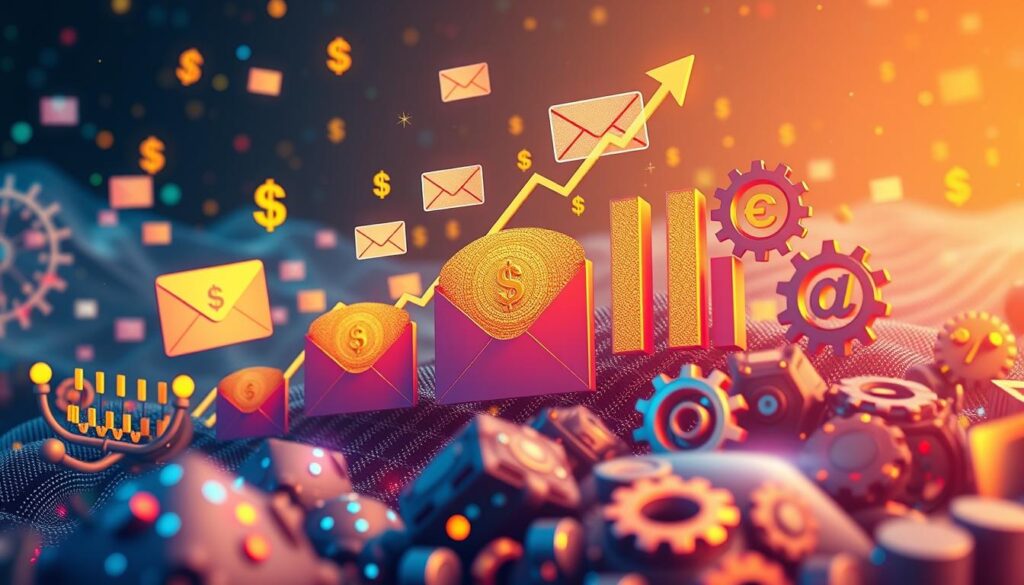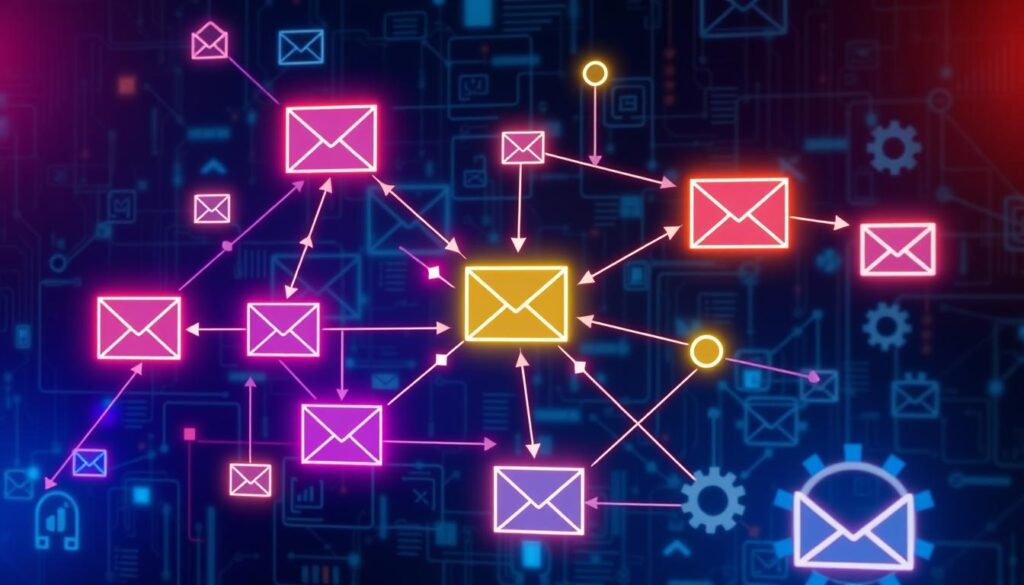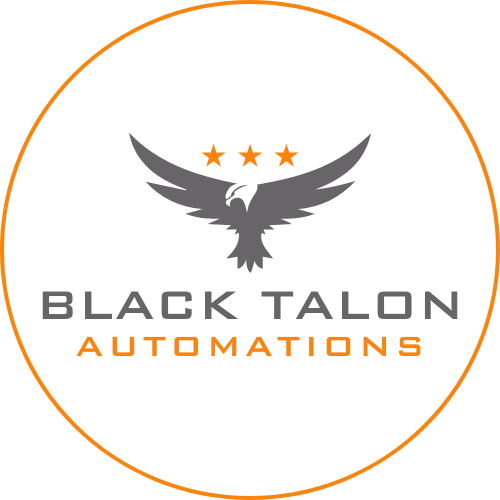Email marketing automation is a game-changer for businesses. With 4.4 billion email users worldwide and 99% checking their inbox daily, email is still the top digital marketing channel. It helps businesses automate tasks, personalize campaigns, and grow their marketing without effort.
This guide will cover the basics of email marketing automation. You’ll learn its benefits, the tools and features you need, and how to create effective workflows. By using automation, you can build strong relationships with your audience, offer personalized experiences, and help your business grow steadily.
Key Takeaways
- Email marketing is a dominant channel with 4.4 billion users worldwide and 99% daily user engagement.
- Automation enables businesses to streamline tasks, create personalized campaigns, and scale their marketing efforts.
- Real-time analytics, reporting, and email list hygiene are crucial for successful email automation campaigns.
- Automated email journeys allow for highly personalized customer experiences and increased engagement.
- Crafting engaging content with relevant data is vital for effective email marketing automation.
Understanding Email Marketing Automation Fundamentals
Email marketing automation helps businesses talk to customers better. It sends emails automatically based on certain actions or times. This way, messages are always on point and meet customer needs.
What is Email Marketing Automation?
Email marketing automation sends emails without needing someone to do it. It makes sure the right message reaches the right people at the right time. This boosts engagement and sales. It also helps guide customers through their customer journey mapping with a personal touch.
Key Components of Automated Email Systems
The main parts of an automated email system are:
- Email marketing software tools to manage and automate the process
- Customer data and segmentation to personalize messaging
- Predefined workflows and triggers to determine when emails are sent
The Role of Triggers and Workflows
Triggers start an automated email sequence. They can be based on what the subscriber does, like leaving something in their cart. Or they can be time-based, like a welcome email. Workflows are the email sequences that guide customers through their journey. They send relevant content and offers until they’re ready to buy.

Using these parts, businesses can make email drip campaigns and lead nurturing emails that work well. They help engage customers, increase sales, and improve marketing results.
The ROI and Benefits of Automated Email Campaigns
Email marketing automation is a smart investment, with studies showing a $36 return for every $1 spent. Automated emails also get a 199% higher click-through rate than regular emails. This shows how well they work in engaging customers.
Automated emails do more than just bring in money. They save time and resources by handling routine tasks. They also help businesses grow by reaching more customers easily. Plus, they make customers feel special with personalized content that matches their interests.
Using automation also helps businesses understand their customers better. In fact, 77% of marketers saw more email engagement in the last year. This proves how effective it is in keeping customers interested.
In the end, email marketing automation is a big win. It boosts revenue, improves customer satisfaction, and makes marketing more efficient. It’s a key part of any good digital marketing plan.

- Email marketing automation generates an average ROI of $36 for every $1 spent.
- Automated emails have a 199% higher click-through rate than mass email campaigns.
- Automated email campaigns save time and resources by streamlining repetitive tasks.
- Personalization capabilities in automation enhance the customer experience and drive engagement.
- Detailed analytics from automated email campaigns provide valuable insights to refine marketing strategies.
- 77% of marketers reported increased email engagement over the past year due to automation.
Essential Tools and Features for Email Automation Success
Choosing the right email automation tools is key for your marketing campaigns’ success. Look for platforms with a user-friendly interface, customizable templates, and advanced segmentation. Also, they should have robust analytics and integrate well with your CRM and e-commerce platforms.
Email Marketing Software Selection Criteria
When picking email marketing automation software, focus on these important features:
- Ease of Use: The platform should be easy to use. This lets you quickly set up and manage your email campaigns.
- Segmentation and Personalization: Choose tools with advanced segmentation and personalization. This way, you can send targeted and relevant content to your subscribers.
- Automation Workflows: Automated email workflows, like triggered messages and drip campaigns, help nurture leads and improve customer engagement.
- Analytics and Reporting: Good reporting tools and real-time analytics are key. They help you measure your email campaign’s performance and make informed decisions.
Integration Capabilities and Requirements
Make sure the email automation tools you pick can integrate well with your other marketing software. This includes CRM systems, e-commerce platforms, and social media platforms. Integration helps you sync customer data and create a unified view of your audience. This leads to more personalized and effective email campaigns.
Analytics and Reporting Tools
Having strong analytics and reporting tools is vital for understanding your email automation success. Look for tools that give detailed metrics on open rates, click-through rates, conversions, and more. This data helps you optimize your campaigns, find areas for improvement, and measure your email automation strategy’s ROI.
Building Effective Email Automation Workflows
Creating effective email automation workflows is key to success in email marketing. It’s important to map out the customer journey and find key moments for automated emails. Start with a strong welcome series for new subscribers. Then, create nurturing campaigns based on what they’re interested in and how they behave.
Trigger-based emails are a powerful tool. Use them for actions like abandoned carts or purchases to reach out at the right time. Segment your emails to send targeted content and make messages more personal for better engagement.
Keep testing and improving your email workflows. Try different structures, how often you send emails, and what you write. Look at metrics like open rates and conversion rates to see what works best.
Effective email automation is an ongoing effort. By making your emails dynamic and personal, you can boost engagement and conversion rates. This leads to a better return on your email marketing investment.

- Map out the customer journey and identify key touchpoints
- Implement a robust welcome sequence for new subscribers
- Create nurturing campaigns based on subscriber interests and behaviors
- Set up trigger-based emails for actions like abandoned carts or purchases
- Leverage segmentation and personalization to deliver targeted content
- Continuously test and refine your workflows based on performance data
By mastering email workflow design, automated email sequences, and trigger-based emails, you can unlock the full potential of email marketing automation. This will drive impressive results for your business.
The Ultimate Guide to Email Marketing Automation Strategy Development
Creating a solid email marketing automation strategy is key for businesses. It helps drive engagement, boost conversions, and build stronger customer relationships. The core of this strategy includes customer journey mapping, email segmentation, and personalization.
Customer Journey Mapping
Start by mapping out your customers’ journey. Identify key touchpoints where email automation can make a big difference. Know your audience’s needs, preferences, and behaviors to create a smooth experience through the sales funnel.
Studies show that using marketing automation software boosts lead generation by 80% and conversions by 77%.
Segmentation Techniques
Effective email segmentation is the base of personalized email marketing. Split your subscriber list into groups based on demographics, browsing behavior, and purchase history. This way, you can send content that really speaks to each customer.
Even a small increase in lead conversion through targeted marketing can greatly boost your revenue.
Personalization Strategies
Personalization is the key to capturing your audience’s attention and driving meaningful engagement. Use customer data to create dynamic content and product recommendations. Send emails that match each subscriber’s interests and needs.
By mastering these strategies, you can improve your customer experience and drive results. Keep analyzing and tweaking your approach based on performance and customer feedback.

Best Practices for Email List Management and Hygiene
Keeping your email list healthy is key for good deliverability and engagement. Regular cleaning and hygiene practices are essential. Start by removing inactive subscribers who haven’t interacted with your emails in 6 months to a year. This helps avoid the negative effects of high churn rates.
Use a double opt-in process for new subscribers to confirm their interest. This reduces the chance of getting invalid or misspelled email addresses. Also, try re-engagement campaigns to bring back inactive subscribers before removing them. Segmenting your list based on engagement helps tailor your content and email frequency.
Watch your bounce rates and spam complaints closely and fix any issues quickly. Following anti-spam laws is also crucial. Make sure to include unsubscribe options and sender info in every email. By following these practices, you can keep your audience engaged and improve your email marketing results.
FAQ
What is email marketing automation?
What are the key components of an automated email system?
What are the benefits of email marketing automation?
FAQ
What is email marketing automation?
Email marketing automation sends emails automatically based on triggers or timelines. It helps businesses save time and create personalized campaigns. This way, they can build strong relationships with their audience.
What are the key components of an automated email system?
An automated email system includes software tools, customer data, and workflows. Triggers can be subscriber actions or specific dates. Workflows are email sequences that guide customers through a journey.
What are the benefits of email marketing automation?
Email marketing automation can bring in for every
FAQ
What is email marketing automation?
Email marketing automation sends emails automatically based on triggers or timelines. It helps businesses save time and create personalized campaigns. This way, they can build strong relationships with their audience.
What are the key components of an automated email system?
An automated email system includes software tools, customer data, and workflows. Triggers can be subscriber actions or specific dates. Workflows are email sequences that guide customers through a journey.
What are the benefits of email marketing automation?
Email marketing automation can bring in $36 for every $1 spent. Automated emails get 199% more clicks than regular emails. It saves time, improves customer experience, and boosts revenue.
What features should I look for in email marketing software?
Look for software with a user-friendly interface and customizable templates. It should have segmentation and analytics. Make sure it integrates with CRM systems and e-commerce platforms. Also, check its scalability, deliverability, and anti-spam compliance.
How do I create effective email automation workflows?
Start by mapping the customer journey and identifying key touchpoints. Create a welcome sequence for new subscribers. Then, use nurturing campaigns based on interests and behaviors.
Use triggered emails for actions like abandoned carts. Segment your list for targeted content. Personalize messaging for better engagement.
What are the key components of an email marketing automation strategy?
A good strategy maps the customer journey and uses segmentation. It personalizes content based on past interactions. Analyze and optimize your strategy regularly to meet customer needs.
How do I maintain a healthy email list?
Clean your list by removing inactive subscribers and updating addresses. Use double opt-in to verify subscribers. Send re-engagement campaigns to inactive subscribers.
Segment your list based on engagement. Monitor bounce rates and spam complaints. Always follow anti-spam laws.
spent. Automated emails get 199% more clicks than regular emails. It saves time, improves customer experience, and boosts revenue.
What features should I look for in email marketing software?
Look for software with a user-friendly interface and customizable templates. It should have segmentation and analytics. Make sure it integrates with CRM systems and e-commerce platforms. Also, check its scalability, deliverability, and anti-spam compliance.
How do I create effective email automation workflows?
Start by mapping the customer journey and identifying key touchpoints. Create a welcome sequence for new subscribers. Then, use nurturing campaigns based on interests and behaviors.
Use triggered emails for actions like abandoned carts. Segment your list for targeted content. Personalize messaging for better engagement.
What are the key components of an email marketing automation strategy?
A good strategy maps the customer journey and uses segmentation. It personalizes content based on past interactions. Analyze and optimize your strategy regularly to meet customer needs.
How do I maintain a healthy email list?
Clean your list by removing inactive subscribers and updating addresses. Use double opt-in to verify subscribers. Send re-engagement campaigns to inactive subscribers.
Segment your list based on engagement. Monitor bounce rates and spam complaints. Always follow anti-spam laws.
What features should I look for in email marketing software?
How do I create effective email automation workflows?
What are the key components of an email marketing automation strategy?
How do I maintain a healthy email list?
Source Links
- https://www.bloomreach.com/en/blog/the-ultimate-email-marketing-automation-guide
- https://blog.beehiiv.com/p/email-marketing-automation-guide
- https://www.zoho.com/campaigns/marketingmatchbox/email-marketing-automation-guide-segmentation-personalization-strategy.html
- https://www.mailerlite.com/ultimate-guide-to-email-marketing/automation
- https://www.businessnewsdaily.com/16296-email-marketing-automation-guide.html
- https://thecmo.com/marketing-automation/marketing-automation-roi/
- https://arinet.com/resources/blog-posts/the-purpose-benefits-of-automated-email-marketing/
- https://convesio.com/knowledgebase/article/the-best-automated-email-campaigns-a-comprehensive-guide/
- https://www.theedigital.com/blog/email-marketing-automation-workflows
- https://www.salesforce.com/marketing/email/automation-guide/
- https://www.linkedin.com/pulse/ultimate-guide-best-tools-email-marketing-success-ashik-imam-kyzhc
- https://leadsbridge.com/blog/how-to-automate-your-emails/
- https://getwpfunnels.com/email-workflow/
- https://mktgessentials.com/blog/a-guide-to-automated-lead-nurturing-workflows
- https://www.munro.agency/email-marketing-automation-the-ultimate-guide/
- https://go.higherlogic.com/rs/016-CFB-719/images/Higher Logic_Guide_The Ultimate Guide to Marketing Automation.pdf
- https://www.campaignmonitor.com/blog/featured/email-list-management-best-practices/
- https://www.emailonacid.com/blog/article/email-deliverability/email-list-cleaning-best-practices/




